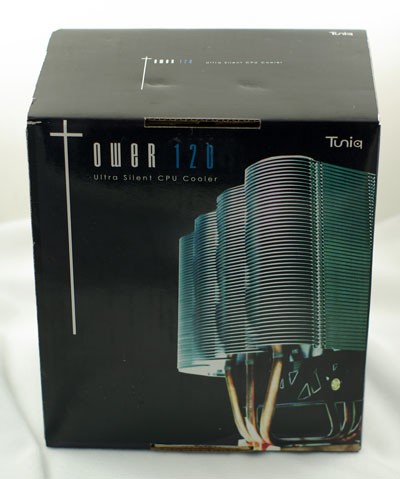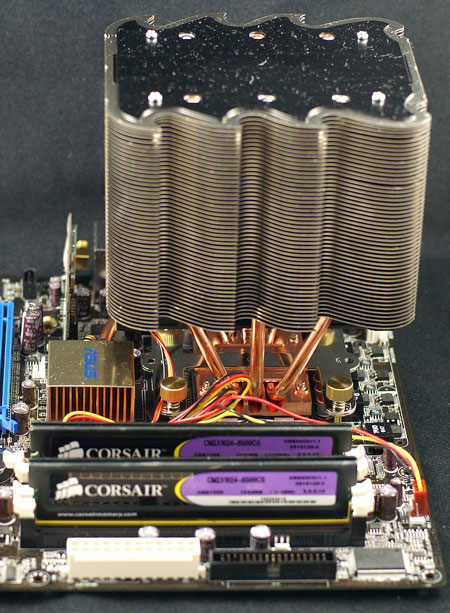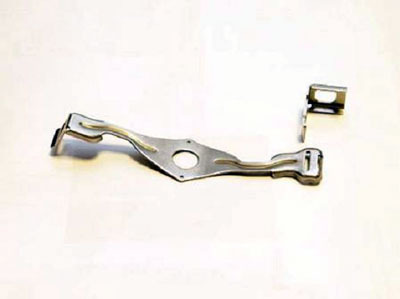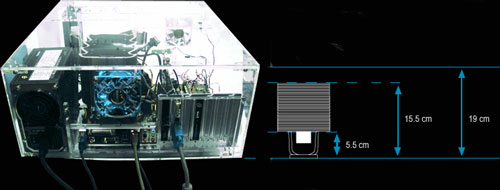Tuniq Tower 120: Air Cooling to the Max
by Wesley Fink on January 15, 2007 12:01 AM EST- Posted in
- Cases/Cooling/PSUs
Sunbeam Tuniq Tower 120

The Tuniq Tower 120 is manufactured by Sunbeam Company, a company based in Taiwan with manufacturing in mainland China. Sunbeamtech was founded in 2000, and the company specializes in PC modding, performance enhancement solutions, and PC cases. Tuniq is a subsidiary of Sunbeam, producing coolers like the Tuniq Tower 120 and specialized PC cases.

The Tower 120 consists of a massive 120mm 9-blade fan in the core of three closed heatpipe loops cooled with a huge number of thin aluminum fins for heat dissipation. The package comes with the special 9-blade fan, a small tube of high performance thermal grease, a fan controller that can mount in an empty expansion slot, and the adapter plate for Intel Socket 775 or AMD K8 (939/940/754).
The Tuniq is very heavy compared to standard heatsinks, which generally fall in the 400g to 650g weight range. At 798g without the fan you will find the final operating weight of the Tuniq 120 close to a kilogram (2.2 lbs). However, this is in line with coolers that take a similar approach to cooling like the Scythe Infinity.

The package does NOT include the adapter for the AMD AM2 processor, but Tuniq tells us the Tower 120 will work on AM2 by using the Zalman ZM-OC1 adapter, which is pictured above. This can be purchased as an accessory from Zalman retailers.

The Tuniq Tower 120 is a massive heatsink, designed to fit mid-tower and full-tower cases. At first glance you may wonder how it could possibly fit in a case, but the height is a bit less than the dimensions of a standard case and the Tuniq will definitely fit a standard case. While the cooler is very large in both width and length it is small at the base. As a result the bulk is above most onboard components around the CPU socket. The bottom line is the Tuniq will fit most motherboards with no problems.

While any 120 mm fan can be used with the Tuniq, the stock fan has 9-blades instead of the more common 7-blade design. This is said to move more air at the same RPM, which allows the fan to be effective at low speeds that are also very quiet. Tuniq strongly encourages that you use the stock fan.

The unit comes standard with a slot-mount fan controller. Specifications indicate the fan dial adjusts fan speed from 1000 to 2000 RPM. These values are very low compared to smaller fans that must run at much higher speeds to be effective. The down-side of higher speed fans is that fan noise normally increases with speed. It is clear Sunbeam chose this huge 120mm fan with 9 blades to reduce noise in this design.










50 Comments
View All Comments
LoneWolf15 - Monday, January 15, 2007 - link
Thanks Wesley, for the review.I'd love to see a complete "cooling tower" review. There are a lot of similar products out there, such as the Sycthe Ninja/Scythe Infinity family, a couple by Noctua, the CoolerMaster Hyper 6+, Arctic's Freezer Pro line, and (sort of similar) Zalman's 9500/9700 line. A lot of us would like to know how they stack up against each other on both Intel and AMD platforms, with the following notes:
Weight of each cooler (lighter being better if it doesn't sacrifice performance)
Ease of mounting on both AMD and Intel systems (with a key to whether the heatsink can be mounted properly for fan exhaust direction, regardless of socket orientation on the mainboard)
Noise level
Cooling effectiveness
Smoothness of CPU mating surface
I've been tempted to buy a tower heatsink/fan unit, as I think it will cool better than my good, but aging Swiftech MCX64-V, since if chosen correctly, a new model should blow air straight to the 120mm exhaust fan at the back of the case. However, I haven't seen a good side-by-side comparison yet that tells me everything I'd wish to know. I hope Anandtech will look into this. Thanks!
AlabamaMan - Monday, January 15, 2007 - link
More pictures would have been very helpfull. I have an e680i mobo and Lian-Li A10 case I still can't fiure out if I can put in the Tower without hitting the top-mounted 120mm case fan.Wesley Fink - Monday, January 15, 2007 - link
If the fan is really at the top, and not at the side of the case (in a tower design) the concerns are different. Considering dimensions toward the physical top (long dimension or height of a tower case), the Tuniq width in that direction is 110mm or 4.3". You can measure from the center of the socket 775 to see if you have 55mm (2.165") clearance to your fan from the center of the socket to the edge of the fan. Just for info the top of the Tuniq is 110mm x 128mm (4.3" x 5").Wesley Fink - Monday, January 15, 2007 - link
The Tuniq Tower dimentions are on page 3. A normal case is 19cm (7.5") deep in the cooler dimension, while the Tuniq is 15.5cm (6.1") tall. I can tell you for a fact the Tuniq clears all components on the 680i baord and can even be used with tall memory mounted (Corsair Diminator for example). You will need to determine if 1.4" is enough clearnace for you fan. Also since the fan would be blowing down on the solid top of the Tuniq, it likely will accomplish nothing as far as cooling is concerned and should be removed.Additional information about the size of the Tuniq can be found at www.tuniq.com
mackintire - Monday, January 15, 2007 - link
I m pretty sure the Tuniq Tower 120 is the best air cooled heatsink.I have a Intel Core 2 Quad QX6700. I do have a Scythe Ninja on it with a scythe 1600rpm S-fan. Running 2 instances of Orthos on all four cores gave me a full load temp of 74C and I know I have too much artic silver 5 on it. So realistically my load temps should be 73-72C.
I just purchased a Noctua NH-U12F which I believe to be really close to the performance of the Tuniq Tower 120.
I think we definately need the Noctua NH-U12F in the best cooler roundup.
The ninja need to be there for reference. And the Scythe Infinity would be a good idea too.
Another item of note is that these larger heavier CPU's show a different delta when loaded up with super hot CPUs.
My quad core running at 3.2 produces mega heat that few heatsinks can deal with.
The reason I switched to the NH-U12F was that it dropped my temp by 8C at stock speeds. 2 C of that I blame on properly application of artic silver.
Either way, this heatsink was well worth the money to me.
mackintire - Monday, January 15, 2007 - link
I changed over to the Noctura this past weekend. Just clearing up my previous post.The Ninja is an excellent heatsink, but I think that there is a limit as to how much heat a heatsink can deal with. I have noticed more recently with the current round of newer solutions that the coolers with more mass tend to deal with larger heat loads better. This is not an exact trend, I m just saying that I haven t found any 300g heatsinks that can perform as well as the better 700g heatsinks under heavy heat loads.
baronzemo78 - Monday, January 15, 2007 - link
Does anyone know how the thermal grease that comes with the Tuniq compares to Arctic Silver 5? Also I would love to see an Andantech article about lapping. I have seen some articles that say that lapping doesn't really improve your temps that much.http://www.overclockers.com/tips458/">http://www.overclockers.com/tips458/
Araemo - Monday, January 15, 2007 - link
Lapping was much more important on Pentium 3s and Athlons that had an exposed CPU Die, and no heat spreader.On modern Intel and AMD CPUs with a heat spreader, the thermal transfer point that needs the highest efficiency is between the heat spreader and the die - you can't do anything about that. The heat spreader gives you much more surface area to transfer the heat with, so the small increase from lapping isn't nearly as important as it used to be.
Perhaps if you're using a Tuniq Tower w/ a super high speed fan and an AC unit blowing at your case inputs and you're trying to break 4Ghz.. it might help. But for us real people, I'd say you're better off spending the time/money on a case with better airflow dynamics or just tying your cables out of the way to maximise airflow.
I have lapped a couple heatsinks, one I did a real half-assed job on, and temps were disappointing(lower than OEM heatsink, but higher than I would have liked).. my last one was used to overclock an AthlonXP mobile from 1.8 to 2.4, and I daresay it helped, but as I mentioned, those AthlonXPs had exposed CPU dies, so you had to transfer the full 60W or whatever using .5 square centimeters of surface area, so improving the transfer rate in any way possible helped.
mino - Monday, January 15, 2007 - link
Please consider doing the tests on Quad CPU(Kentsfield) as well as on a Duo CPU.Many coolers while beeing great for C2D perform poorly on Quad and vice versa.
Avalon - Monday, January 15, 2007 - link
I'd like to see the Coolermaster Hyper TX included if possible!Good review!